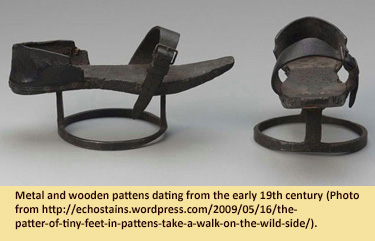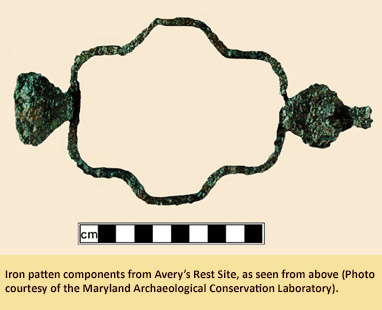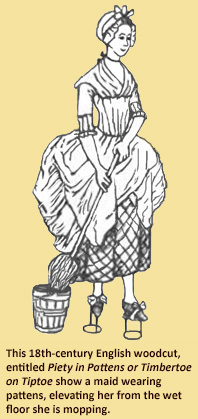Curator's Choice 2010
Pattens
September 2010
By Patricia Samford, MAC Lab Director
 In June of 2010, archaeologists working for the University of California at Los Angeles announced the discovery in an Armenian cave of a 5,500 year old shoe (Belluck 2010). Crafted from cowhide, this exciting find has been heralded as the world’s oldest shoe. While discoveries like this one demonstrate that protective footgear has been around for thousands of years, the advent of paved surfaces to help ease travel lagged centuries behind.
In June of 2010, archaeologists working for the University of California at Los Angeles announced the discovery in an Armenian cave of a 5,500 year old shoe (Belluck 2010). Crafted from cowhide, this exciting find has been heralded as the world’s oldest shoe. While discoveries like this one demonstrate that protective footgear has been around for thousands of years, the advent of paved surfaces to help ease travel lagged centuries behind.
In the past, travelers often had to contend with unpaved roads made a soupy mess by rains or an obstacle course from animal waste. The non-waterproof nature of early shoes, coupled with messy road conditions, led to the development of devices designed to elevate travelers off the ground. In addition to keeping feet and women’s long gowns clear of road debris, pattens also raised a wearer's feet off cold stone flooring. Wooden examples of these devices, commonly called pattens, have been discovered in European and English archaeological sites dating as early as the 12th century (Grew and de Neergaard 1988). At first high status items, their use had filtered down to the general population by the end of the 15th century.
 The patten pictured here is from a seventeenth-century archaeological site in Delaware known as Avery’s Rest. This plantation near the Rehoboth Bay was owned during the early fourth quarter of the seventeenth century by Captain John and Sarah Avery and later by the Avery's daughter and her husband. The Archaeological Society of Delaware and the State of Delaware have been excavating the Avery's Rest Site since 2006. The patten arrived at the Maryland Archaeological Conservation Laboratory in 2009; one of a group of objects needing conservation prior to their inclusion in an exhibit on display at the Rehoboth Beach Museum until April 2011. The patten was one of many artifacts recovered from a cellar hole that was filled with trash between the 1690s and circa 1720.
The patten pictured here is from a seventeenth-century archaeological site in Delaware known as Avery’s Rest. This plantation near the Rehoboth Bay was owned during the early fourth quarter of the seventeenth century by Captain John and Sarah Avery and later by the Avery's daughter and her husband. The Archaeological Society of Delaware and the State of Delaware have been excavating the Avery's Rest Site since 2006. The patten arrived at the Maryland Archaeological Conservation Laboratory in 2009; one of a group of objects needing conservation prior to their inclusion in an exhibit on display at the Rehoboth Beach Museum until April 2011. The patten was one of many artifacts recovered from a cellar hole that was filled with trash between the 1690s and circa 1720.
While early pattens were wooden with leather straps to hold them to the feet, metal rings also began to be used as components of pattens. The Avery's Rest patten was crafted of iron and was probably very similar in construction to the 19th-century example shown here. Pattens were not always easy to walk in; Samuel Pepys noted in his diary entry of January 24, 1660 that his wife was "exceedingly troubled with a pair of new pattens, and I vexed her to go slow." (Pepys 1660).
The increased occurrence of paved roads and sidewalks, along with the nineteenth-century invention of rubber galoshes signaled the death knell for this curious form of footwear.
Acknowledgements:
The author would like to thank Dan Griffith and the Archaeological Society of Delaware for graciously allowing me to make the patten from Avery's Rest the subject of a Curator's Choice essay.
| References |
|
| Belluck, Pam |
| 2010 |
This Shoe Had Prada Beat by 5,500 Years. New York Times. June 9, 2010. |
|
| Grew, Francis and Margrethe de Neergaard |
| 1988 |
Shoes and Pattens; Medieveal Finds from Excavations in London. London: Her Majesty’s Stationery Office. |
|
| Pepys, Samuel |
| n.d. |
The Diary of Samuel Pepys Complete 1660 N.S. Hardpress.net. |
|